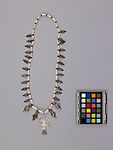Necklace
About this object
History of use
Silver ornaments represent an important part of early exchange between Europeans, including fur traders, and First Nations people, especially in Eastern and Central Canada and the USA. Initially, the main sources of silver were British, French, and Spanish coins. Most ornaments were produced by silversmiths of European origin in North America and Europe, and were actively traded only from 1760 to 1821. By the mid-18th century silver objects were produced in New England, Quebec and Montreal. Silver was used by First Nations people as a sign of rank. Silver ornaments in these styles continue to be produced by native silversmiths in Central Canada and the USA. The cross was the oldest form of trade silver, introduced by French missionaries to North America for presentation to converts. Crosses were later used as trade silver with no religious connotations. They circulated well into the 19th century, and were worn on the chest. Animal imagery is a significant part of Woodland First Nations tradition, but no documented instance has been found of the use of animal effigies in trade. The place of effigies in Woodlands culture is not known.
Cultural context
trade; personal ornamentation; political alliance
Physical description
Necklace of glass beads, silver beavers and silver Lorraine Cross. The beads are mostly white and off-white, with a blue or rust-red bead between every five. There are twenty-four small hollow beaver effigies with crosshatched tails, alternating with beads. Some beavers have holes which have been refilled with a different coloured metal. There are four larger solid beavers at the bottom of the necklace, two each side of the cross. The cross has cloverleaf terminals and the front is engraved with diverging curling lines and scroll-like patterns on the vertical stem. All beavers stamped with maker's mark. The base of the cross also stamped with maker's mark.
Categories
Materials
Subjects
Date Made
1760-1821
Date Acquired
9 Sep 1993
How Acquired
Donated
Credit Line
Measurements
0.4 x 33.5 x 8 cm
Object Number
1590/99
